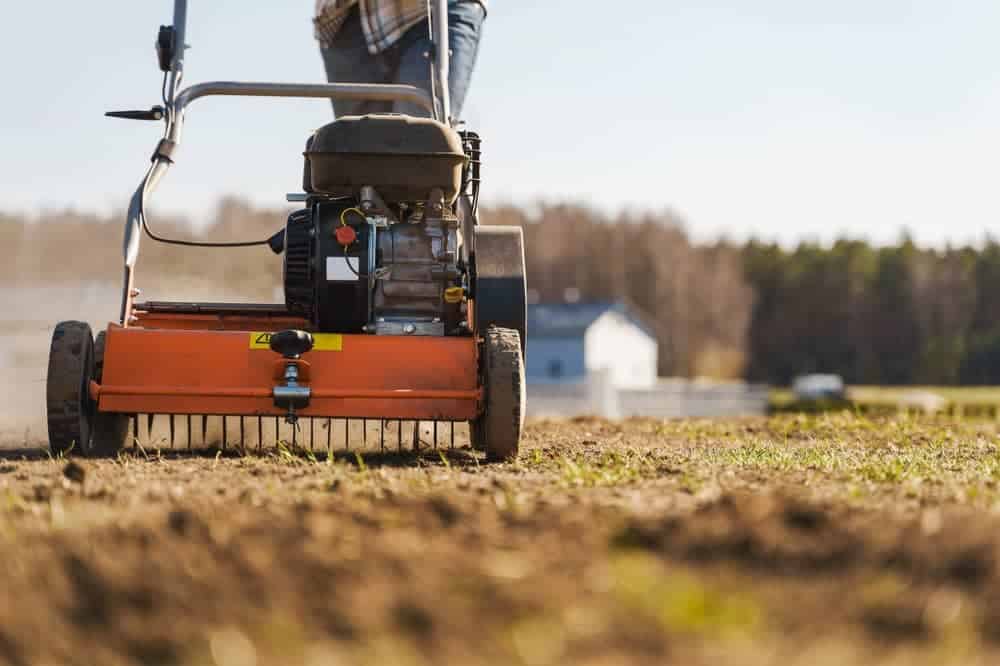Your lawn needs more than a trim and a splash of water to thrive.
Heavy rain, daily footsteps, or kids running around can gradually compact the soil.
This can suffocate the grass and block water and nutrients from reaching the roots.
That’s where aeration comes in, loosening the soil to let your lawn breathe.
It’s one of the best ways to keep your turf lush and green!
When to Aerate | How Often to Aerate | Signs to Aerate | How to Aerate | What to Do After
What Is Lawn Aeration?
Aeration is a lawn care technique. It involves creating small holes or slices in the soil to loosen it.
This allows air, water, and nutrients to reach the grass roots, helping your turf grow healthier!
For home gardeners, there are two main types of lawn aeration: core and spike aeration.
When choosing the best way to aerate a lawn, you should consider your lawn size and soil type.
SIZE OF THE AREA: A mechanical aerator is more efficient for larger lawns. But for smaller areas, a handheld tool is enough.
SOIL TYPE: Core aeration is generally more effective, even for compacted soil like clay. Spike aeration works best on loam or sandy soil.
Core aeration
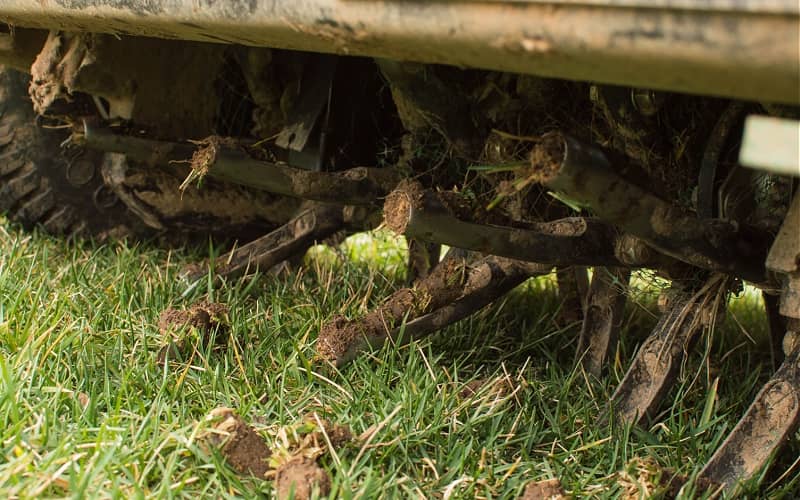
Core aeration uses a tool with hollow tines to extract small soil plugs across the lawn.
By creating more space in the soil, core aeration greatly improves air and water flow.
That’s why it’s suitable for all soil types, including clay.
However, core aeration leaves excavated soil plugs on the lawn.
The plugs naturally decompose and enrich the soil, but they can be unsightly for some people.
There are different core aerators:
CORE AERATOR MACHINES: Available as walk-behind (push-type) or tow-behind (pulled by a tractor).
HANDHELD CORE AERATORS: Fork-style tools that remove soil plugs when pushed into the ground.
Spike aeration
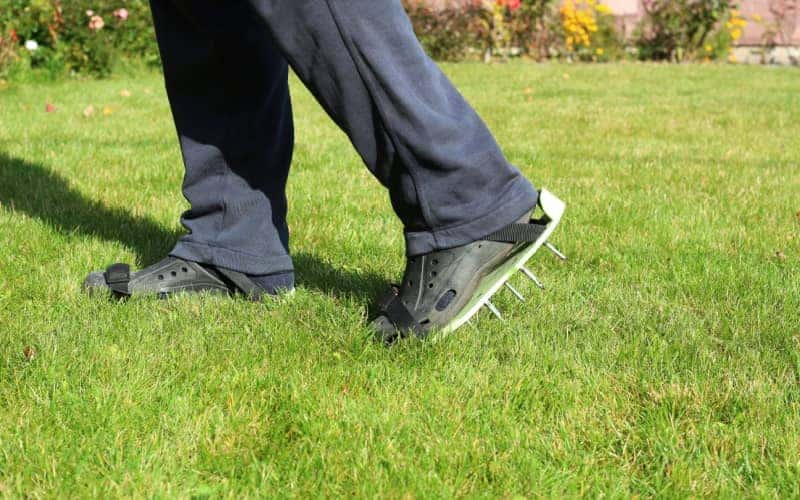
Spike aeration uses solid tines or spikes to create holes in the ground without removing soil plugs.
It’s generally faster and more affordable than core aeration.
However, spike aerators push the soil aside instead of pulling out plugs.
This compresses the surrounding soil and compacts it more over time.
So while spike aeration can work on loam or sandy soils — which are looser — it’s less effective on heavy clay.
Spike aerators include:
AERATOR SHOES: Sandals with spikes that puncture the soil as you walk.
HANDHELD SPIKE AERATORS: Some look like garden forks, while others have a rolling drum with spikes.
SPIKE AERATOR MACHINES: Can be walk-behind (push-type) or tow-behind (pulled by a tractor).
Why Do You Need to Aerate Your Lawn?
Aeration is essential to maintain a healthy lawn! It helps address issues that can hinder grass growth.
ALLEVIATE SOIL COMPACTION: Aeration loosens the soil so grass roots can absorb nutrients easily.
REDUCE THATCH: Aeration helps break down thatch (a layer of dead plant matter) to improve water and nutrient delivery.
IMPROVE DRAINAGE: Aeration enhances drainage and prevents waterlogging, which reduces the risk of plant disease.
ENCOURAGE TURF GROWTH: Healthier soil on your lawn leads to thicker, stronger grass.
When to Aerate the Lawn
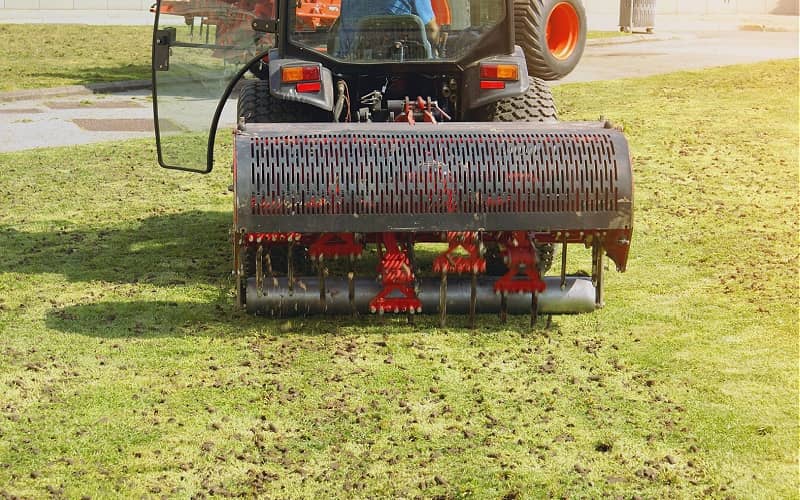
In Australia, the best time to aerate your lawn is during the growing season.
Consider the type of lawn grass you have.
For warm season grasses like Buffalo and Couch, aerate the lawn in spring to early summer (September to December).
For cool season grasses like Fescue and Kentucky Blue, aerate in autumn (March to May) as the weather cools.
How Often to Aerate the Lawn
How often to aerate the lawn depends on its health and soil type. Generally, you can aerate every 1–3 years.
Here’s a general guide:
- Clay soil: Aerate at least once a year
- Sandy or loam soil: Aerate every 2-3 years or longer
Clay soil is naturally more dense, so it benefits from more frequent aeration.
Meanwhile, sandy and loam soils are more porous. They don’t need to be aerated as often as clay.
However, you can also aerate as needed if your lawn is struggling with poor drainage or soil compaction.
Do not aerate too often, though!
Excessive aeration can stress the grass or cause the soil to dry up much faster.
Signs to Aerate the Lawn
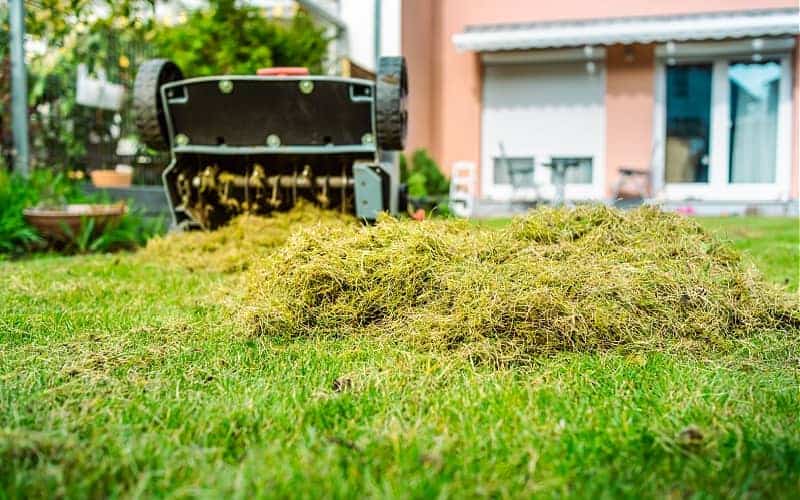
You need to aerate the lawn if air, water, and nutrients can’t reach the soil beneath the grass.
This can happen if there’s excessive lawn thatch.
Look out for compacted soil, too.
If footprints remain visible long after walking, the soil may be too dense and tightly packed.
Puddles that linger after rainfall or watering the lawn also suggest poor drainage.
Over time, these lawn issues can cause browning, thinning, or yellowing grass.
If you notice any of these problems, it’s time to aerate your lawn!
How to Aerate a Lawn Properly
Aerating a lawn takes a lot of time and effort. Plus, you need the right tools to make it a success.
If you prefer, you can hire a lawn maintenance service to handle the job.
But if you’re up for the task and have the tools ready, you can do it yourself.
Here’s what you’ll need:
- Thatch rake
- Lawn mower
- Lawn aerator
- Garden hose or sprinkler
And remember: wear gloves and a dust mask to protect yourself from allergens!
Step 1: Choose the right tool
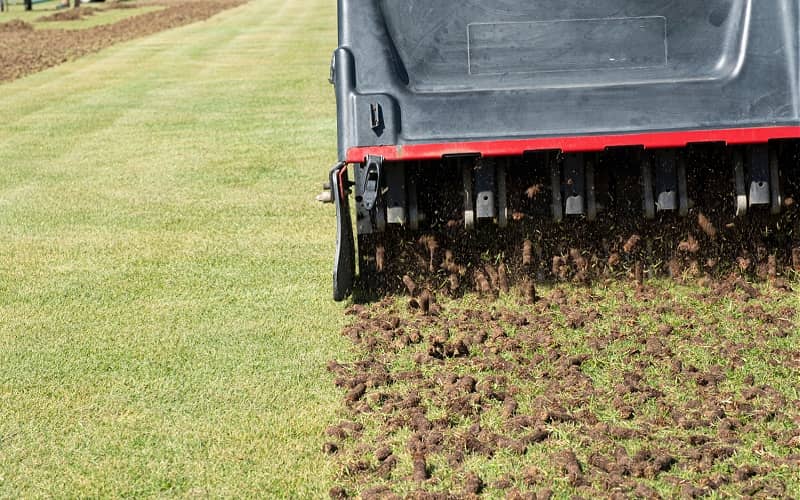
First, choose the right aeration equipment for your lawn.
Core aerators are suitable for all types of soil, including heavy clay.
Spike aerators can work on sandy or loamy soil, but they’re less effective on dense ground.
Step 2 (optional): Test the soil pH
Test the soil pH using a soil pH tester. You can buy one at a garden centre or online.
Knowing the soil pH allows you to choose the right amendments or top dressing after aeration.
Step 3: Dethatch and mow the lawn
It’s best to dethatch and mow the lawn 1-3 days before aerating.
Apart from making the process more manageable, it also allows the grass to recover before aeration.
Dethatch the lawn to help the aerator penetrate the soil better.
Then, use a lawn mower to cut about one-third of the grass.
However, keep the grass at least 4cm tall. Cutting it too short (also called scalping) can be stressful to the turf!
Afterwards, clear away grass clippings so they don’t get in the way while aerating.
Step 4: Water the lawn

Water the lawn with a hose or sprinkler the day before aerating.
Dampen the soil just enough to make it moist but not muddy.
This softens the soil and makes aeration easier.
Step 5: Aerate the lawn
After dethatching, mowing, and watering the lawn, it’s time to start the aeration process!
When using a handheld aerator, make holes about 5–10cm deep into the ground and 10–15cm apart.
Work one section of the lawn at a time so you don’t miss a spot.
If you’re using a mechanical aerator, make multiple passes in different directions for even coverage.
Move the aerator in one direction across the entire lawn. Then, make a second pass perpendicular to the first.
You can also make a third diagonal pass if the soil is extremely compacted.
Afterwards, leave any soil plugs to dry naturally on the lawn.
What to Do After Aerating the Lawn
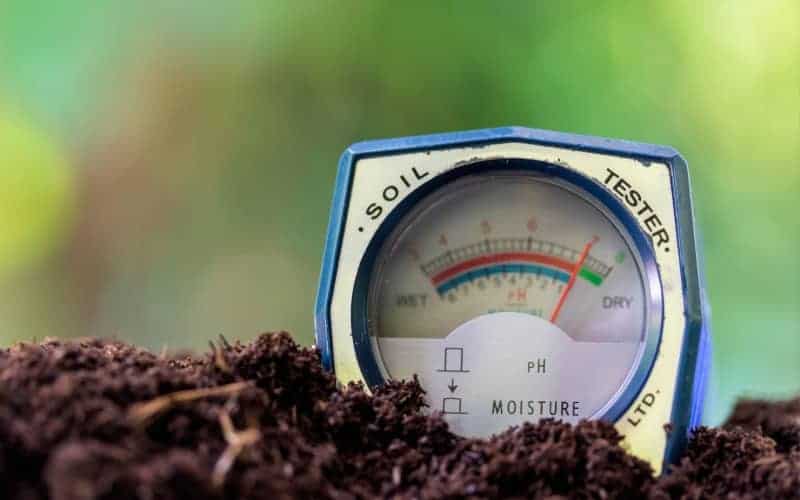
If your soil pH test shows high acidity, apply lime to neutralise acidic soils. Follow the product instructions carefully.
But if the soil is too alkaline, lower the pH using aluminium sulphate or elemental sulphur.
To improve your lawn’s health further, top dressing the lawn is a great option. It fills the holes and improves soil structure.
You can also overseed the lawn to encourage turf growth in bare patches.
Afterwards, water the lawn thoroughly. Keep the soil moist but not soggy to support seed germination.
While waiting for the soil and grass to recover after aeration, stay off the lawn for a few days.
The yard should start looking more vibrant and fuller in a few weeks!
Signs of Over-Aeration
Lawn aerating is generally beneficial. However, doing it too often or too aggressively can harm the grass.
It may disturb or damage the root system, which stunts grass growth.
Over time, this might lead to more bare patches on the lawn.
Excessive aeration can also dry out the soil by increasing evaporation.
Spike aeration in particular can increase soil compaction if done too frequently.
The solid tines push the soil aside, which can compress the soil between the holes.
FAQs: More About Lawn Aeration
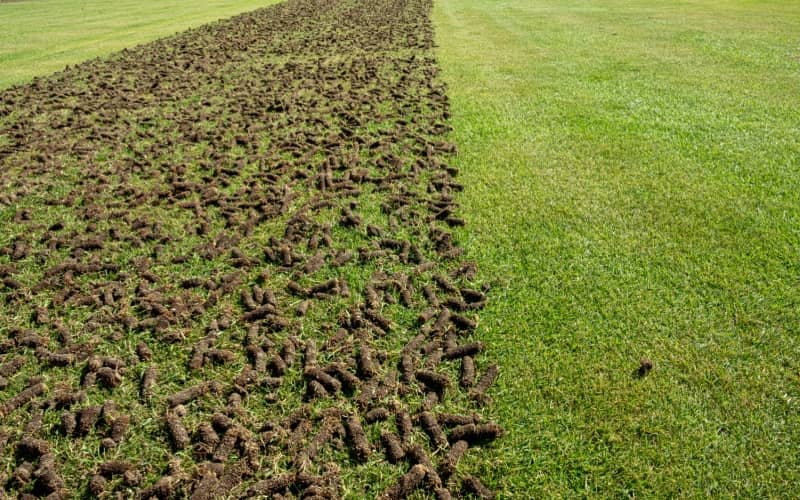
Got more questions about how to help your lawn breathe? Here’s what you need to know.
Should you remove soil plugs after aerating?
No, removing soil plugs after core aeration is not recommended.
The soil plugs contain valuable nutrients. As they break down, they act as a natural fertiliser.
If they look messy, lightly rake them to spread the soil evenly across the lawn.
Do you need to aerate the entire lawn?
Generally, you only need to aerate the entire lawn if the problem is widespread, like thatch covering a large area.
Otherwise, aeration doesn’t need to be a major lawn care operation if only certain parts are affected.
For instance, the soil might be more compacted in areas with plenty of foot traffic, like pathways. Some parts may also be prone to thinning.
In these cases, spot aeration may be better.
That way, you can tackle problem areas without disturbing the rest of the lawn.
Does aeration benefit Australian native grass?
Yes! While Australian native grasses are naturally hardy, aeration can still help.
If the soil is too dense, loosening it can improve drainage and nutrient availability.
Even if native grasses can grow in low-nutrient conditions, that extra boost will help them thrive.
Before you start, assess your native lawn’s condition to see if it truly needs to be aerated.
How to aerate the lawn by hand
If you don’t have a core or spike aerator, you can use a garden fork.
Push the tines about 5–10cm deep into the ground. Then, move the fork back and forth to loosen the soil.
Repeat this process across your lawn. Make sure to space the holes 10–15cm apart.
Keep in mind that this method is best for small sections or spot aeration.
It’s also not as effective as core aeration for extremely compacted soil.
How to aerate rocky soil
Be cautious when aerating rocky soils. Rocks can damage core aerators or bend spike aerators!
First, clear as many rocks as you can from the surface.
Then, sift the soil to remove any rocks lodged underneath.
If the soil is very rocky, a garden fork may work better than a core or spike aerator.
However, it’s a slow process and is better suited to small areas.
As an alternative, you can top dress the lawn with topsoil and compost.
This can help improve the soil structure and drainage, even without aeration.

